Remediation in Millers Point Gasworks in Barangaroo
VerifiedAdded on 2023/01/23
|11
|2445
|59
AI Summary
This report aims to remediate the contamination caused by the Millers Point Gasworks in Barangaroo, focusing on pollution levels, contamination aspects, health risks, and possible remediation methods. It highlights the importance of ensuring environmental safety and the health of the inhabitants.
Contribute Materials
Your contribution can guide someone’s learning journey. Share your
documents today.
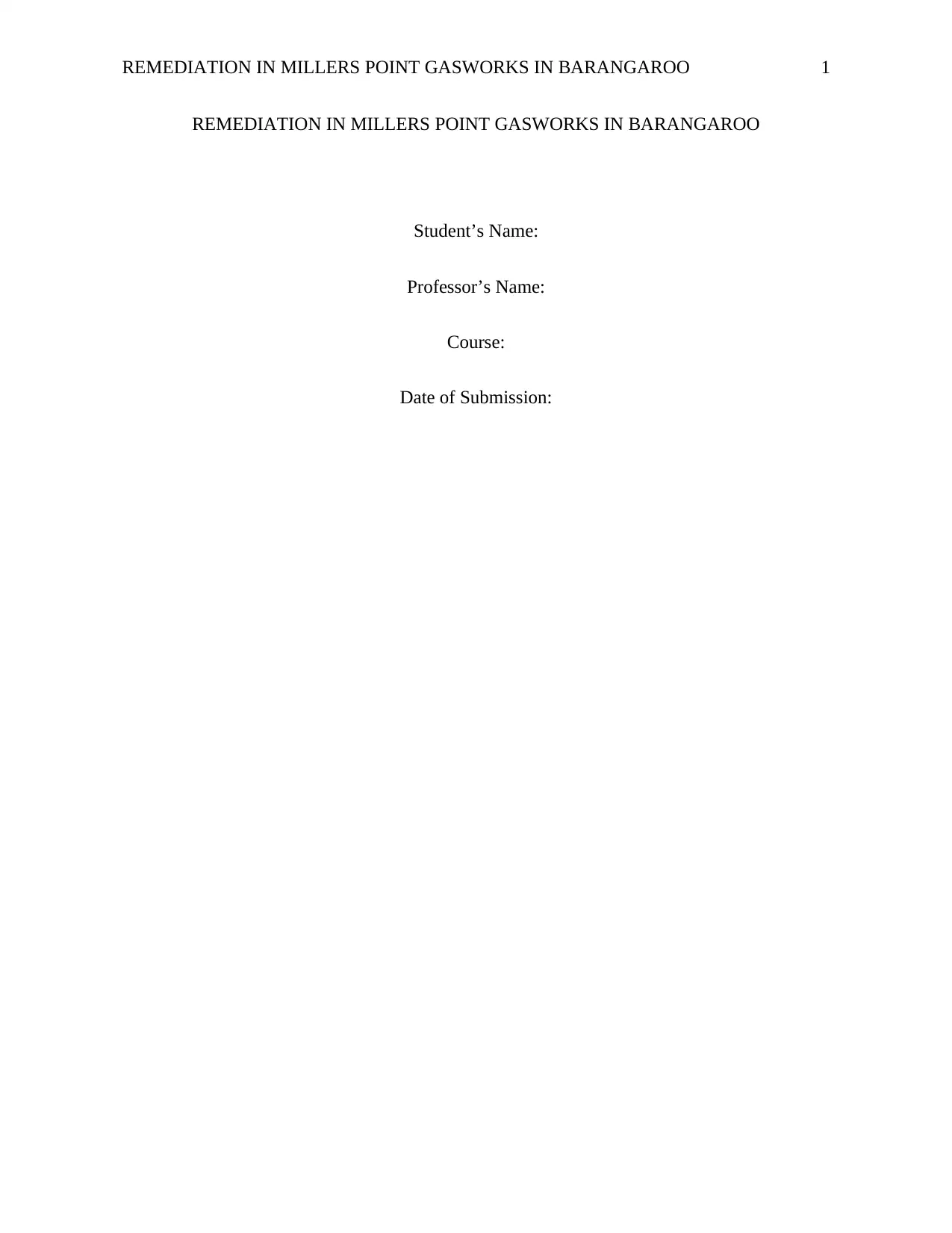
REMEDIATION IN MILLERS POINT GASWORKS IN BARANGAROO 1
REMEDIATION IN MILLERS POINT GASWORKS IN BARANGAROO
Student’s Name:
Professor’s Name:
Course:
Date of Submission:
REMEDIATION IN MILLERS POINT GASWORKS IN BARANGAROO
Student’s Name:
Professor’s Name:
Course:
Date of Submission:
Secure Best Marks with AI Grader
Need help grading? Try our AI Grader for instant feedback on your assignments.
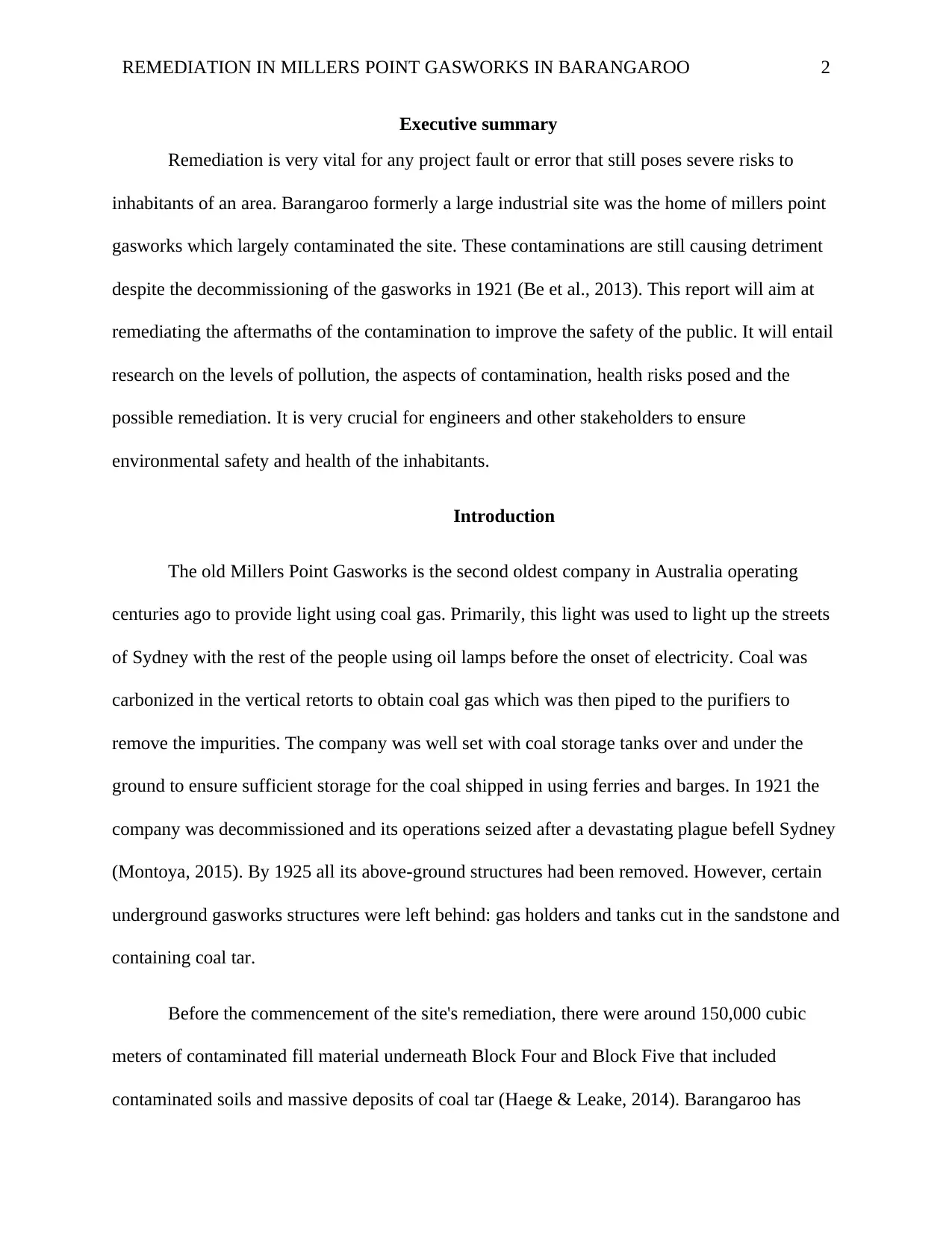
REMEDIATION IN MILLERS POINT GASWORKS IN BARANGAROO 2
Executive summary
Remediation is very vital for any project fault or error that still poses severe risks to
inhabitants of an area. Barangaroo formerly a large industrial site was the home of millers point
gasworks which largely contaminated the site. These contaminations are still causing detriment
despite the decommissioning of the gasworks in 1921 (Be et al., 2013). This report will aim at
remediating the aftermaths of the contamination to improve the safety of the public. It will entail
research on the levels of pollution, the aspects of contamination, health risks posed and the
possible remediation. It is very crucial for engineers and other stakeholders to ensure
environmental safety and health of the inhabitants.
Introduction
The old Millers Point Gasworks is the second oldest company in Australia operating
centuries ago to provide light using coal gas. Primarily, this light was used to light up the streets
of Sydney with the rest of the people using oil lamps before the onset of electricity. Coal was
carbonized in the vertical retorts to obtain coal gas which was then piped to the purifiers to
remove the impurities. The company was well set with coal storage tanks over and under the
ground to ensure sufficient storage for the coal shipped in using ferries and barges. In 1921 the
company was decommissioned and its operations seized after a devastating plague befell Sydney
(Montoya, 2015). By 1925 all its above-ground structures had been removed. However, certain
underground gasworks structures were left behind: gas holders and tanks cut in the sandstone and
containing coal tar.
Before the commencement of the site's remediation, there were around 150,000 cubic
meters of contaminated fill material underneath Block Four and Block Five that included
contaminated soils and massive deposits of coal tar (Haege & Leake, 2014). Barangaroo has
Executive summary
Remediation is very vital for any project fault or error that still poses severe risks to
inhabitants of an area. Barangaroo formerly a large industrial site was the home of millers point
gasworks which largely contaminated the site. These contaminations are still causing detriment
despite the decommissioning of the gasworks in 1921 (Be et al., 2013). This report will aim at
remediating the aftermaths of the contamination to improve the safety of the public. It will entail
research on the levels of pollution, the aspects of contamination, health risks posed and the
possible remediation. It is very crucial for engineers and other stakeholders to ensure
environmental safety and health of the inhabitants.
Introduction
The old Millers Point Gasworks is the second oldest company in Australia operating
centuries ago to provide light using coal gas. Primarily, this light was used to light up the streets
of Sydney with the rest of the people using oil lamps before the onset of electricity. Coal was
carbonized in the vertical retorts to obtain coal gas which was then piped to the purifiers to
remove the impurities. The company was well set with coal storage tanks over and under the
ground to ensure sufficient storage for the coal shipped in using ferries and barges. In 1921 the
company was decommissioned and its operations seized after a devastating plague befell Sydney
(Montoya, 2015). By 1925 all its above-ground structures had been removed. However, certain
underground gasworks structures were left behind: gas holders and tanks cut in the sandstone and
containing coal tar.
Before the commencement of the site's remediation, there were around 150,000 cubic
meters of contaminated fill material underneath Block Four and Block Five that included
contaminated soils and massive deposits of coal tar (Haege & Leake, 2014). Barangaroo has
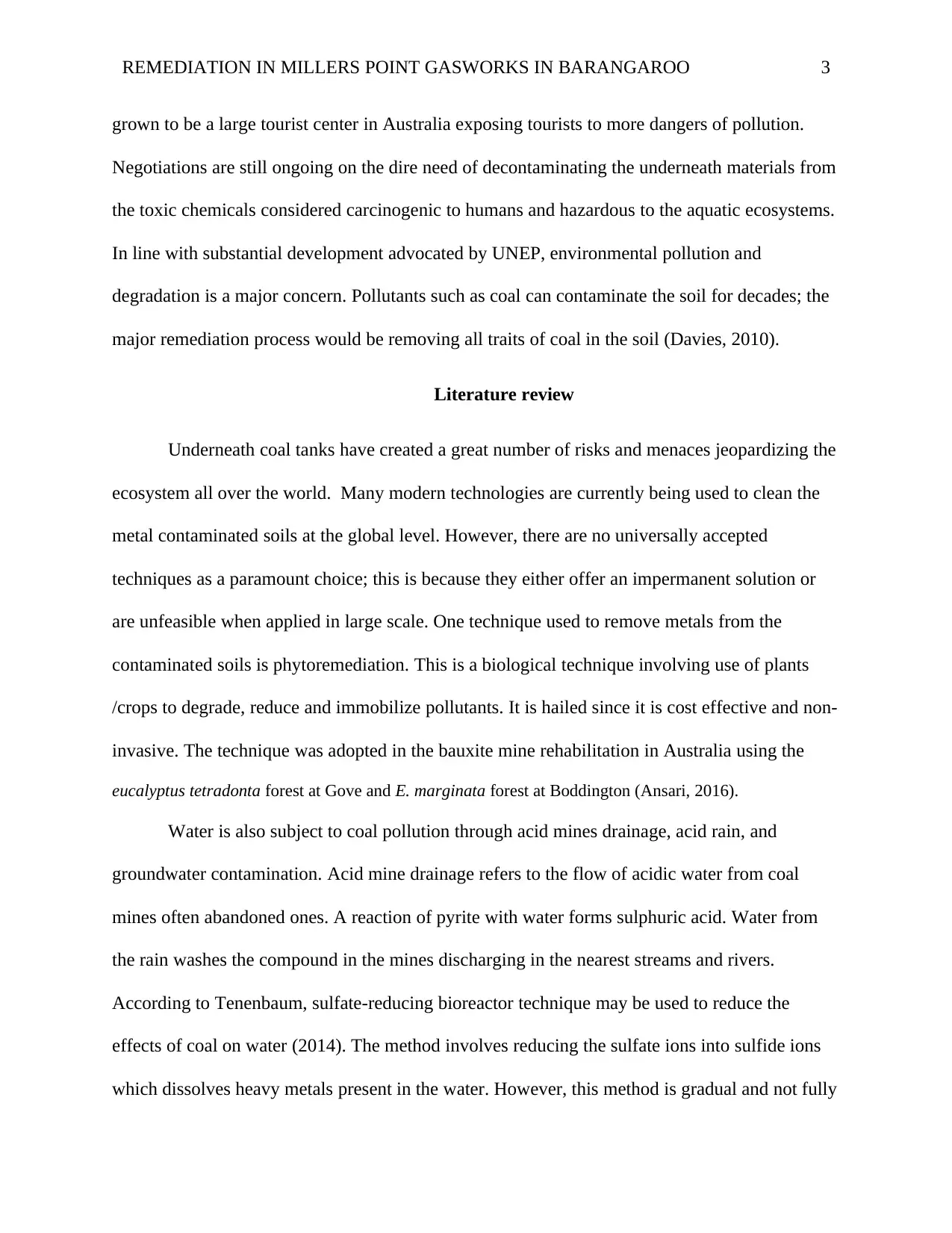
REMEDIATION IN MILLERS POINT GASWORKS IN BARANGAROO 3
grown to be a large tourist center in Australia exposing tourists to more dangers of pollution.
Negotiations are still ongoing on the dire need of decontaminating the underneath materials from
the toxic chemicals considered carcinogenic to humans and hazardous to the aquatic ecosystems.
In line with substantial development advocated by UNEP, environmental pollution and
degradation is a major concern. Pollutants such as coal can contaminate the soil for decades; the
major remediation process would be removing all traits of coal in the soil (Davies, 2010).
Literature review
Underneath coal tanks have created a great number of risks and menaces jeopardizing the
ecosystem all over the world. Many modern technologies are currently being used to clean the
metal contaminated soils at the global level. However, there are no universally accepted
techniques as a paramount choice; this is because they either offer an impermanent solution or
are unfeasible when applied in large scale. One technique used to remove metals from the
contaminated soils is phytoremediation. This is a biological technique involving use of plants
/crops to degrade, reduce and immobilize pollutants. It is hailed since it is cost effective and non-
invasive. The technique was adopted in the bauxite mine rehabilitation in Australia using the
eucalyptus tetradonta forest at Gove and E. marginata forest at Boddington (Ansari, 2016).
Water is also subject to coal pollution through acid mines drainage, acid rain, and
groundwater contamination. Acid mine drainage refers to the flow of acidic water from coal
mines often abandoned ones. A reaction of pyrite with water forms sulphuric acid. Water from
the rain washes the compound in the mines discharging in the nearest streams and rivers.
According to Tenenbaum, sulfate-reducing bioreactor technique may be used to reduce the
effects of coal on water (2014). The method involves reducing the sulfate ions into sulfide ions
which dissolves heavy metals present in the water. However, this method is gradual and not fully
grown to be a large tourist center in Australia exposing tourists to more dangers of pollution.
Negotiations are still ongoing on the dire need of decontaminating the underneath materials from
the toxic chemicals considered carcinogenic to humans and hazardous to the aquatic ecosystems.
In line with substantial development advocated by UNEP, environmental pollution and
degradation is a major concern. Pollutants such as coal can contaminate the soil for decades; the
major remediation process would be removing all traits of coal in the soil (Davies, 2010).
Literature review
Underneath coal tanks have created a great number of risks and menaces jeopardizing the
ecosystem all over the world. Many modern technologies are currently being used to clean the
metal contaminated soils at the global level. However, there are no universally accepted
techniques as a paramount choice; this is because they either offer an impermanent solution or
are unfeasible when applied in large scale. One technique used to remove metals from the
contaminated soils is phytoremediation. This is a biological technique involving use of plants
/crops to degrade, reduce and immobilize pollutants. It is hailed since it is cost effective and non-
invasive. The technique was adopted in the bauxite mine rehabilitation in Australia using the
eucalyptus tetradonta forest at Gove and E. marginata forest at Boddington (Ansari, 2016).
Water is also subject to coal pollution through acid mines drainage, acid rain, and
groundwater contamination. Acid mine drainage refers to the flow of acidic water from coal
mines often abandoned ones. A reaction of pyrite with water forms sulphuric acid. Water from
the rain washes the compound in the mines discharging in the nearest streams and rivers.
According to Tenenbaum, sulfate-reducing bioreactor technique may be used to reduce the
effects of coal on water (2014). The method involves reducing the sulfate ions into sulfide ions
which dissolves heavy metals present in the water. However, this method is gradual and not fully

REMEDIATION IN MILLERS POINT GASWORKS IN BARANGAROO 4
effective for large scale polluted water. The Barangaroo Delivery Authority ( the organization
tasked with the remediation task) proposed sealing the contaminated area with concrete to
contain the water within a bathtub-like structure and pumping it away for treatment.
According to enormous research, the coal burning by-products including fly ash, flue gas-
sludge and bottom ash contains mercury and uranium which have severe effects on human
health. Barangaroo being a former coal industrial powerhouse contains many coal-burning
byproducts which expose endangers the ecosystem (Hughes, 2018). A redevelopment program
involving several apartments and a hotel was scheduled to be raised. However, the remediation
process is derailing their establishments. According to humanitarian agencies in Australia, a man
in Barangaroo complained of headaches later succumbing to these pains. After several tests, the
brain was seen to be heavily affected by mercury; this leading to his death (Barangaroo delivery
authority et al., 2011).
Research objectives and goals
To stop the rampant ecosystem pollution persistently affecting Barangaroo, remediation
of millers point gasworks is fundamental. The overall aim of this project is to curb the extensive
threats posed to tourists and residents by the coal tanks left in the area. To perform the
decontamination process, the level of contamination, areas most affected by the contamination
and the possible ways to rehabilitate the contamination must be determined and established
(Davis, 2011). The object of this report is to determine the extent of pollution due to
underground coal tanks and ways to rectify the pollution. The project will hence involve
numerous surveys in the area to assess the extent of damage and the amount of effort and
resources required for remediation.
effective for large scale polluted water. The Barangaroo Delivery Authority ( the organization
tasked with the remediation task) proposed sealing the contaminated area with concrete to
contain the water within a bathtub-like structure and pumping it away for treatment.
According to enormous research, the coal burning by-products including fly ash, flue gas-
sludge and bottom ash contains mercury and uranium which have severe effects on human
health. Barangaroo being a former coal industrial powerhouse contains many coal-burning
byproducts which expose endangers the ecosystem (Hughes, 2018). A redevelopment program
involving several apartments and a hotel was scheduled to be raised. However, the remediation
process is derailing their establishments. According to humanitarian agencies in Australia, a man
in Barangaroo complained of headaches later succumbing to these pains. After several tests, the
brain was seen to be heavily affected by mercury; this leading to his death (Barangaroo delivery
authority et al., 2011).
Research objectives and goals
To stop the rampant ecosystem pollution persistently affecting Barangaroo, remediation
of millers point gasworks is fundamental. The overall aim of this project is to curb the extensive
threats posed to tourists and residents by the coal tanks left in the area. To perform the
decontamination process, the level of contamination, areas most affected by the contamination
and the possible ways to rehabilitate the contamination must be determined and established
(Davis, 2011). The object of this report is to determine the extent of pollution due to
underground coal tanks and ways to rectify the pollution. The project will hence involve
numerous surveys in the area to assess the extent of damage and the amount of effort and
resources required for remediation.
Secure Best Marks with AI Grader
Need help grading? Try our AI Grader for instant feedback on your assignments.
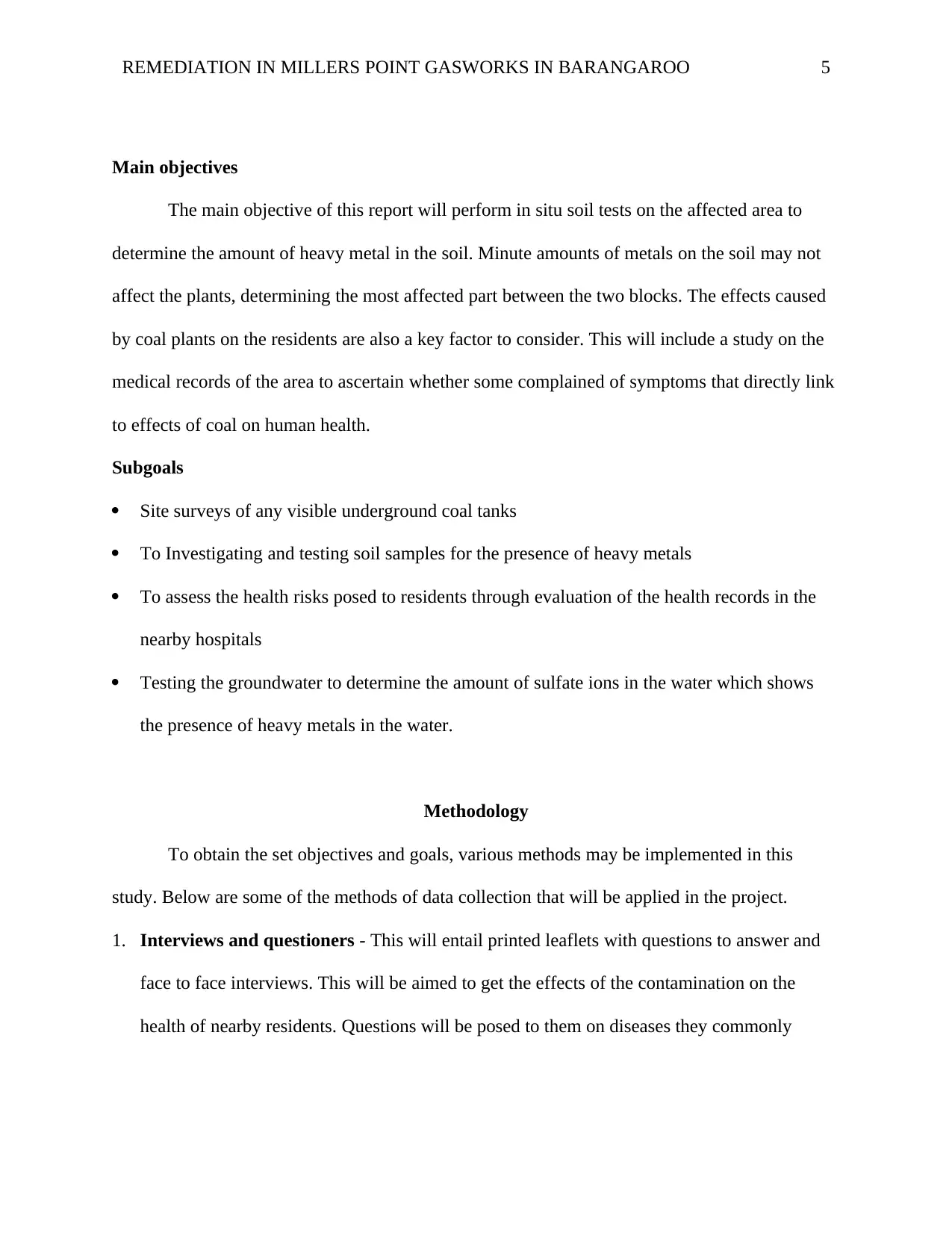
REMEDIATION IN MILLERS POINT GASWORKS IN BARANGAROO 5
Main objectives
The main objective of this report will perform in situ soil tests on the affected area to
determine the amount of heavy metal in the soil. Minute amounts of metals on the soil may not
affect the plants, determining the most affected part between the two blocks. The effects caused
by coal plants on the residents are also a key factor to consider. This will include a study on the
medical records of the area to ascertain whether some complained of symptoms that directly link
to effects of coal on human health.
Subgoals
Site surveys of any visible underground coal tanks
To Investigating and testing soil samples for the presence of heavy metals
To assess the health risks posed to residents through evaluation of the health records in the
nearby hospitals
Testing the groundwater to determine the amount of sulfate ions in the water which shows
the presence of heavy metals in the water.
Methodology
To obtain the set objectives and goals, various methods may be implemented in this
study. Below are some of the methods of data collection that will be applied in the project.
1. Interviews and questioners - This will entail printed leaflets with questions to answer and
face to face interviews. This will be aimed to get the effects of the contamination on the
health of nearby residents. Questions will be posed to them on diseases they commonly
Main objectives
The main objective of this report will perform in situ soil tests on the affected area to
determine the amount of heavy metal in the soil. Minute amounts of metals on the soil may not
affect the plants, determining the most affected part between the two blocks. The effects caused
by coal plants on the residents are also a key factor to consider. This will include a study on the
medical records of the area to ascertain whether some complained of symptoms that directly link
to effects of coal on human health.
Subgoals
Site surveys of any visible underground coal tanks
To Investigating and testing soil samples for the presence of heavy metals
To assess the health risks posed to residents through evaluation of the health records in the
nearby hospitals
Testing the groundwater to determine the amount of sulfate ions in the water which shows
the presence of heavy metals in the water.
Methodology
To obtain the set objectives and goals, various methods may be implemented in this
study. Below are some of the methods of data collection that will be applied in the project.
1. Interviews and questioners - This will entail printed leaflets with questions to answer and
face to face interviews. This will be aimed to get the effects of the contamination on the
health of nearby residents. Questions will be posed to them on diseases they commonly
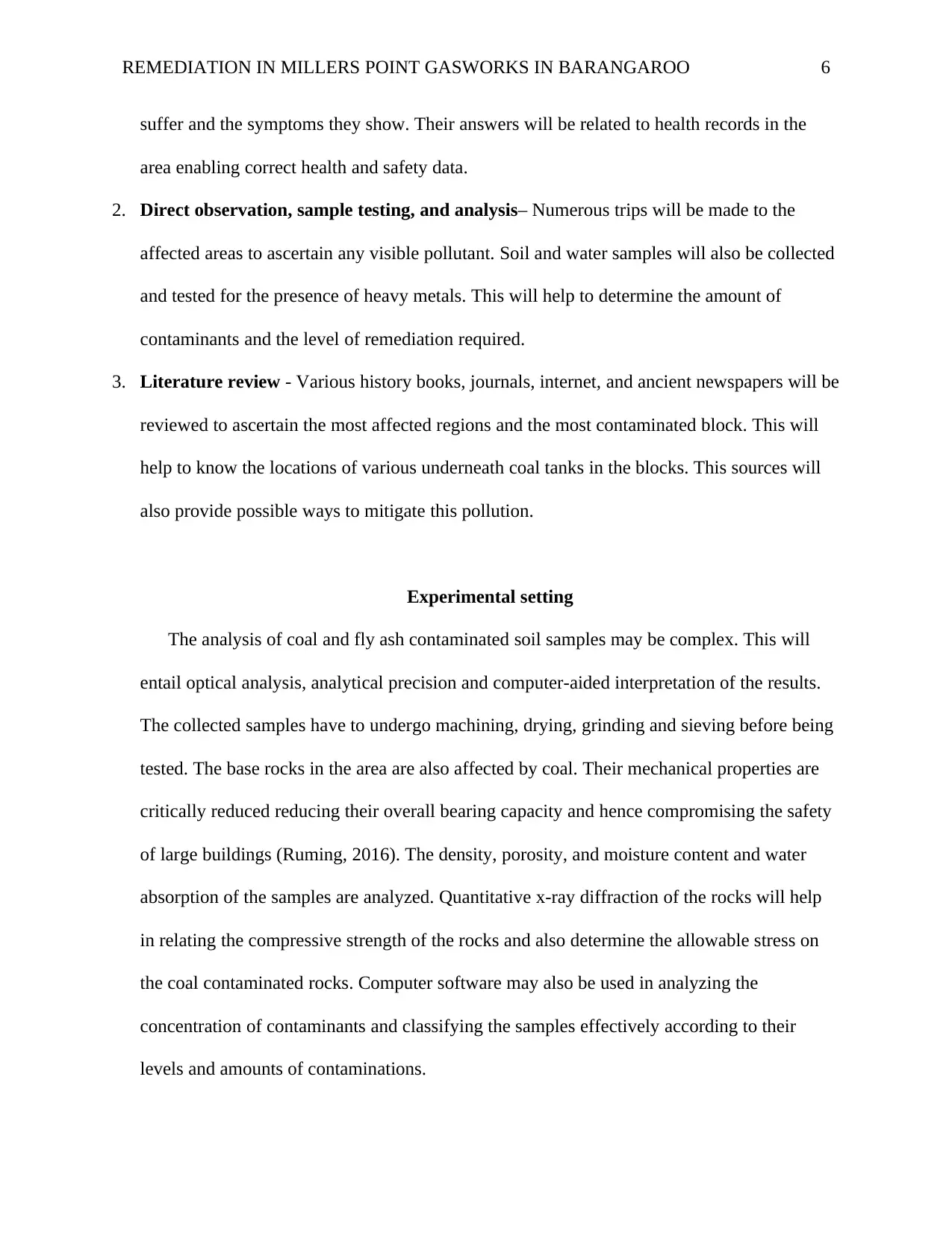
REMEDIATION IN MILLERS POINT GASWORKS IN BARANGAROO 6
suffer and the symptoms they show. Their answers will be related to health records in the
area enabling correct health and safety data.
2. Direct observation, sample testing, and analysis– Numerous trips will be made to the
affected areas to ascertain any visible pollutant. Soil and water samples will also be collected
and tested for the presence of heavy metals. This will help to determine the amount of
contaminants and the level of remediation required.
3. Literature review - Various history books, journals, internet, and ancient newspapers will be
reviewed to ascertain the most affected regions and the most contaminated block. This will
help to know the locations of various underneath coal tanks in the blocks. This sources will
also provide possible ways to mitigate this pollution.
Experimental setting
The analysis of coal and fly ash contaminated soil samples may be complex. This will
entail optical analysis, analytical precision and computer-aided interpretation of the results.
The collected samples have to undergo machining, drying, grinding and sieving before being
tested. The base rocks in the area are also affected by coal. Their mechanical properties are
critically reduced reducing their overall bearing capacity and hence compromising the safety
of large buildings (Ruming, 2016). The density, porosity, and moisture content and water
absorption of the samples are analyzed. Quantitative x-ray diffraction of the rocks will help
in relating the compressive strength of the rocks and also determine the allowable stress on
the coal contaminated rocks. Computer software may also be used in analyzing the
concentration of contaminants and classifying the samples effectively according to their
levels and amounts of contaminations.
suffer and the symptoms they show. Their answers will be related to health records in the
area enabling correct health and safety data.
2. Direct observation, sample testing, and analysis– Numerous trips will be made to the
affected areas to ascertain any visible pollutant. Soil and water samples will also be collected
and tested for the presence of heavy metals. This will help to determine the amount of
contaminants and the level of remediation required.
3. Literature review - Various history books, journals, internet, and ancient newspapers will be
reviewed to ascertain the most affected regions and the most contaminated block. This will
help to know the locations of various underneath coal tanks in the blocks. This sources will
also provide possible ways to mitigate this pollution.
Experimental setting
The analysis of coal and fly ash contaminated soil samples may be complex. This will
entail optical analysis, analytical precision and computer-aided interpretation of the results.
The collected samples have to undergo machining, drying, grinding and sieving before being
tested. The base rocks in the area are also affected by coal. Their mechanical properties are
critically reduced reducing their overall bearing capacity and hence compromising the safety
of large buildings (Ruming, 2016). The density, porosity, and moisture content and water
absorption of the samples are analyzed. Quantitative x-ray diffraction of the rocks will help
in relating the compressive strength of the rocks and also determine the allowable stress on
the coal contaminated rocks. Computer software may also be used in analyzing the
concentration of contaminants and classifying the samples effectively according to their
levels and amounts of contaminations.
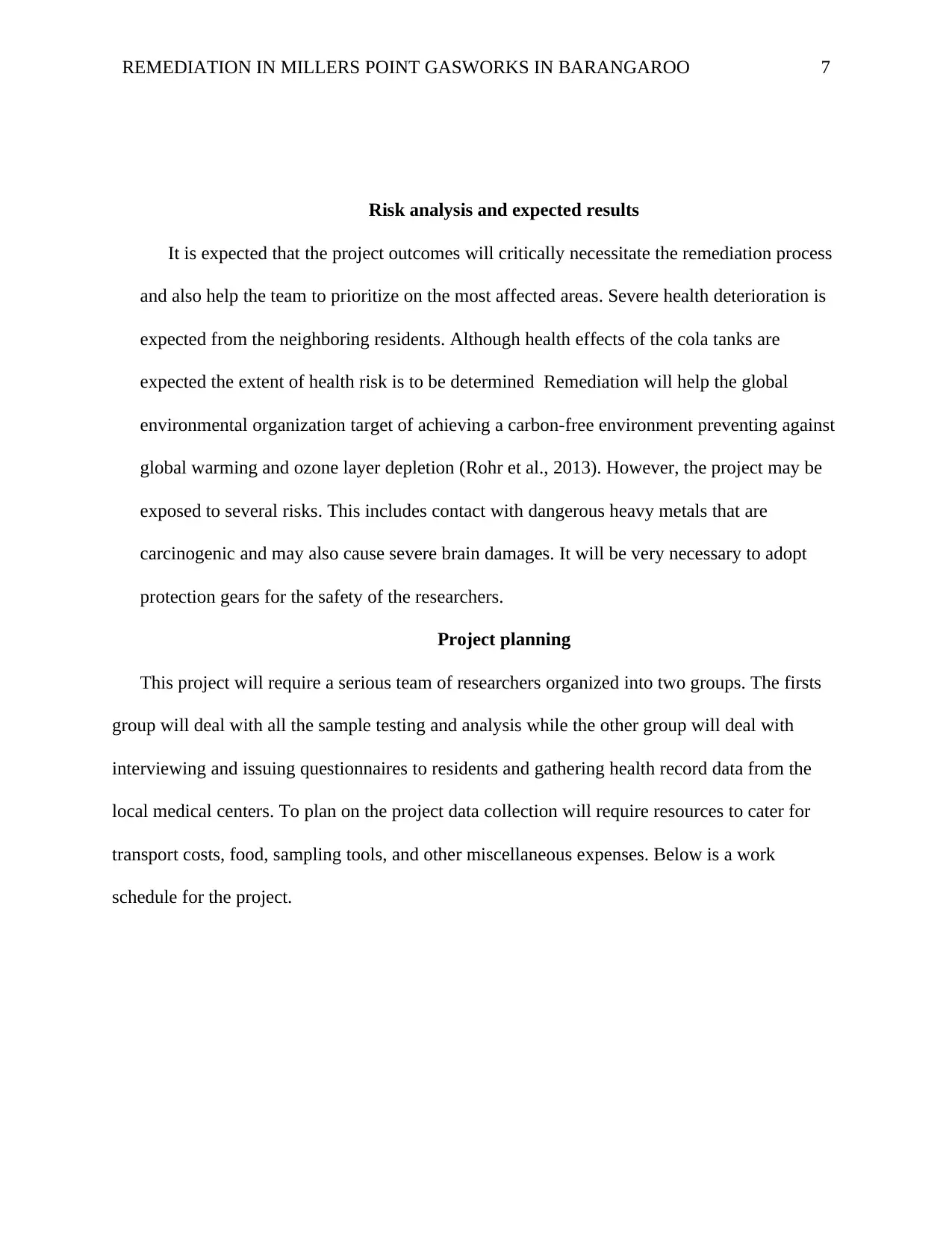
REMEDIATION IN MILLERS POINT GASWORKS IN BARANGAROO 7
Risk analysis and expected results
It is expected that the project outcomes will critically necessitate the remediation process
and also help the team to prioritize on the most affected areas. Severe health deterioration is
expected from the neighboring residents. Although health effects of the cola tanks are
expected the extent of health risk is to be determined Remediation will help the global
environmental organization target of achieving a carbon-free environment preventing against
global warming and ozone layer depletion (Rohr et al., 2013). However, the project may be
exposed to several risks. This includes contact with dangerous heavy metals that are
carcinogenic and may also cause severe brain damages. It will be very necessary to adopt
protection gears for the safety of the researchers.
Project planning
This project will require a serious team of researchers organized into two groups. The firsts
group will deal with all the sample testing and analysis while the other group will deal with
interviewing and issuing questionnaires to residents and gathering health record data from the
local medical centers. To plan on the project data collection will require resources to cater for
transport costs, food, sampling tools, and other miscellaneous expenses. Below is a work
schedule for the project.
Risk analysis and expected results
It is expected that the project outcomes will critically necessitate the remediation process
and also help the team to prioritize on the most affected areas. Severe health deterioration is
expected from the neighboring residents. Although health effects of the cola tanks are
expected the extent of health risk is to be determined Remediation will help the global
environmental organization target of achieving a carbon-free environment preventing against
global warming and ozone layer depletion (Rohr et al., 2013). However, the project may be
exposed to several risks. This includes contact with dangerous heavy metals that are
carcinogenic and may also cause severe brain damages. It will be very necessary to adopt
protection gears for the safety of the researchers.
Project planning
This project will require a serious team of researchers organized into two groups. The firsts
group will deal with all the sample testing and analysis while the other group will deal with
interviewing and issuing questionnaires to residents and gathering health record data from the
local medical centers. To plan on the project data collection will require resources to cater for
transport costs, food, sampling tools, and other miscellaneous expenses. Below is a work
schedule for the project.
Paraphrase This Document
Need a fresh take? Get an instant paraphrase of this document with our AI Paraphraser
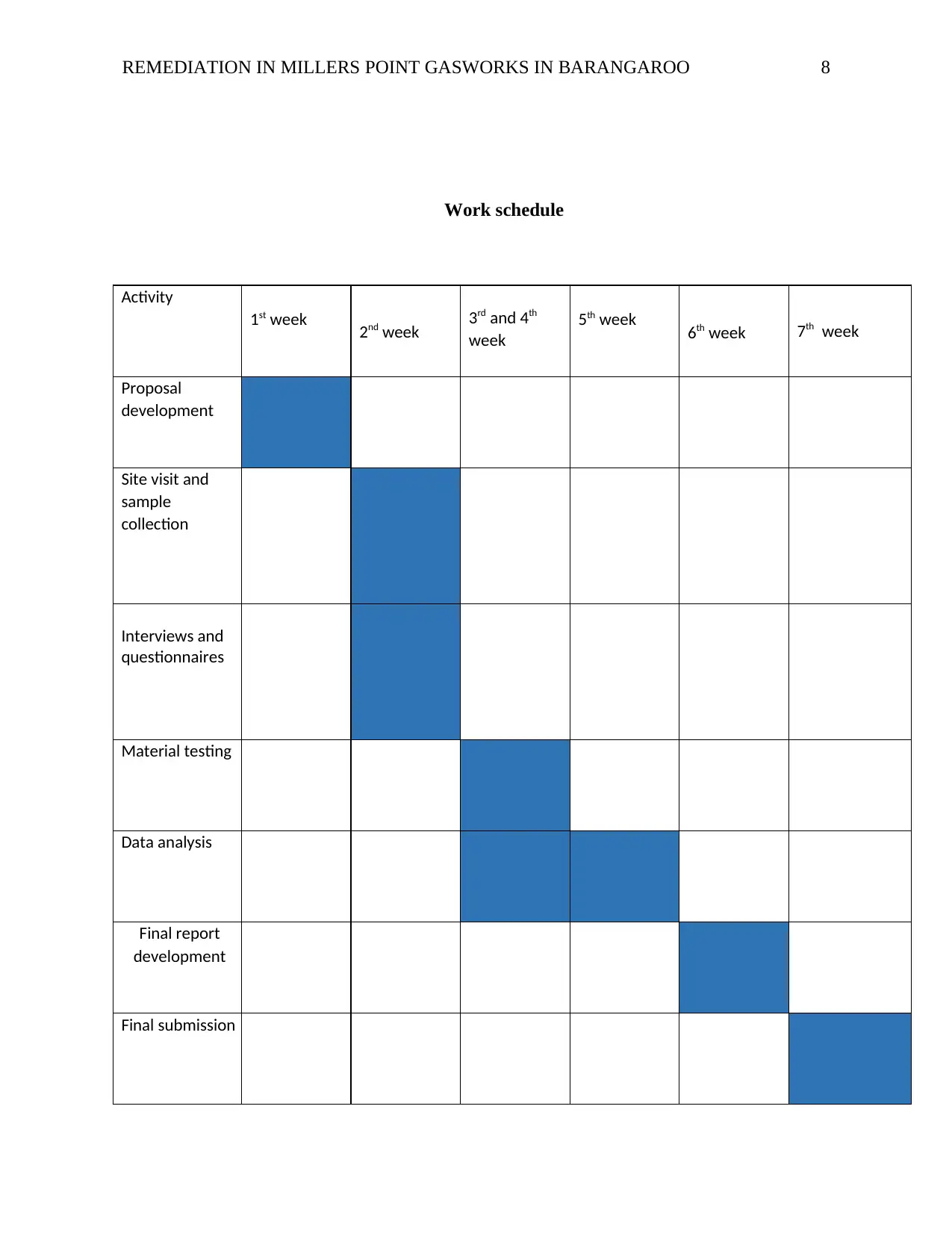
REMEDIATION IN MILLERS POINT GASWORKS IN BARANGAROO 8
Work schedule
Activity
1st week 2nd week 3rd and 4th
week
5th week 6th week 7th week
Proposal
development
Site visit and
sample
collection
Interviews and
questionnaires
Material testing
Data analysis
Final report
development
Final submission
Work schedule
Activity
1st week 2nd week 3rd and 4th
week
5th week 6th week 7th week
Proposal
development
Site visit and
sample
collection
Interviews and
questionnaires
Material testing
Data analysis
Final report
development
Final submission

REMEDIATION IN MILLERS POINT GASWORKS IN BARANGAROO 9
Conclusion
Coal is termed as one of the most dangerous sources of energy. Burning of coal releases
some of the most dangerous greenhouse gases. Coal remains are also fundamental soil and water
pollutants. Coal reduces the ultimate soil and rock bearing capacity compromising the safety of
structures erected on the contaminated soils. It also has severe effects on plants which grow on
the contaminated soil. The plants growing on the polluted soil intake dangerous compounds
which they later transmit to the ecosystem including animals and humans. The compounds have
severe health effects causing critical brain damages and cancers. Remediation of such soils
would hence prove very vital for any country. Remediation will involve cleansing the polluted
soils and removing pollutants. The rapid growth of Barangaroo in terms of tourism and
infrastructure critically necessitates remediation to guarantee the overall safety of tourists and
also the erected structures.
Conclusion
Coal is termed as one of the most dangerous sources of energy. Burning of coal releases
some of the most dangerous greenhouse gases. Coal remains are also fundamental soil and water
pollutants. Coal reduces the ultimate soil and rock bearing capacity compromising the safety of
structures erected on the contaminated soils. It also has severe effects on plants which grow on
the contaminated soil. The plants growing on the polluted soil intake dangerous compounds
which they later transmit to the ecosystem including animals and humans. The compounds have
severe health effects causing critical brain damages and cancers. Remediation of such soils
would hence prove very vital for any country. Remediation will involve cleansing the polluted
soils and removing pollutants. The rapid growth of Barangaroo in terms of tourism and
infrastructure critically necessitates remediation to guarantee the overall safety of tourists and
also the erected structures.
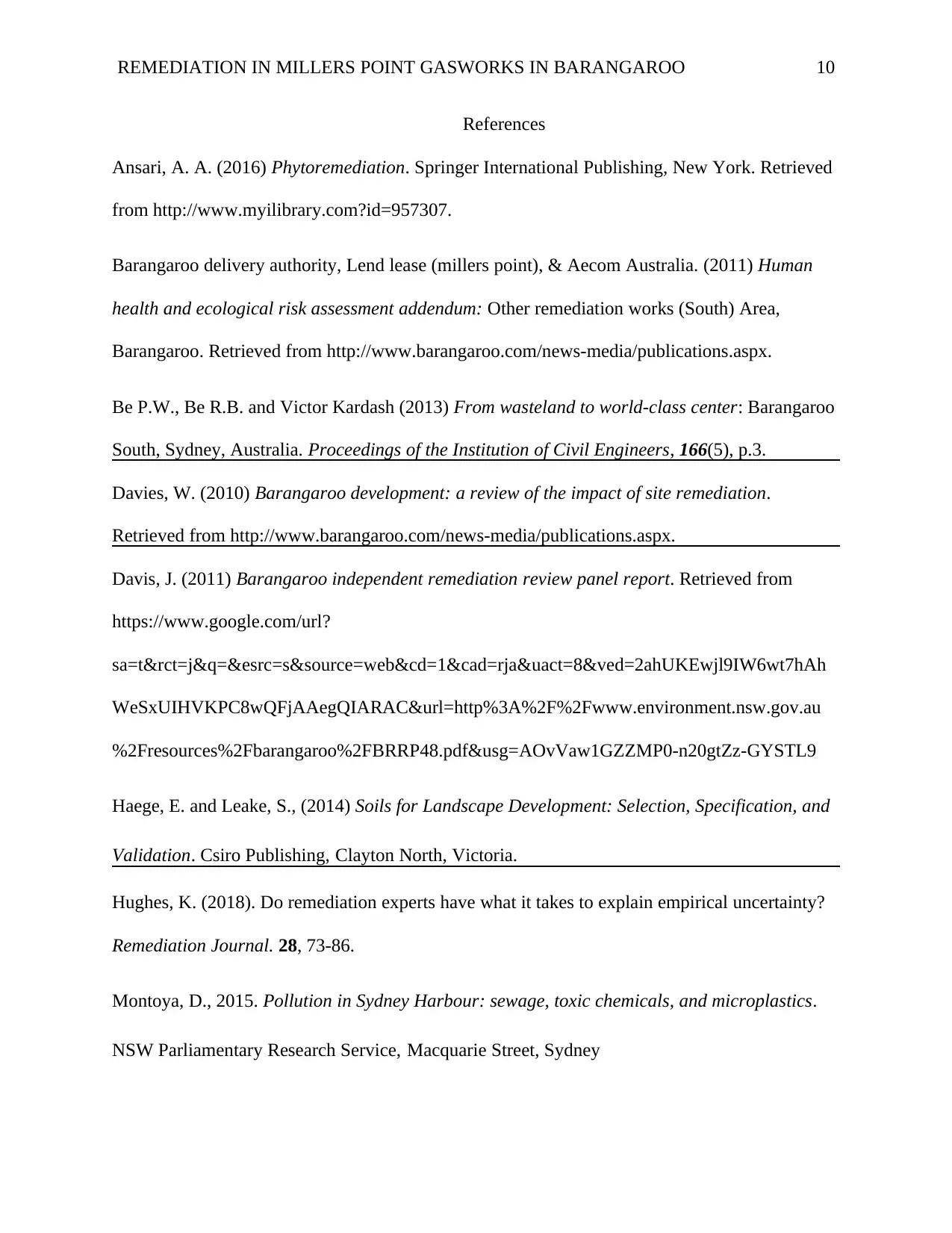
REMEDIATION IN MILLERS POINT GASWORKS IN BARANGAROO 10
References
Ansari, A. A. (2016) Phytoremediation. Springer International Publishing, New York. Retrieved
from http://www.myilibrary.com?id=957307.
Barangaroo delivery authority, Lend lease (millers point), & Aecom Australia. (2011) Human
health and ecological risk assessment addendum: Other remediation works (South) Area,
Barangaroo. Retrieved from http://www.barangaroo.com/news-media/publications.aspx.
Be P.W., Be R.B. and Victor Kardash (2013) From wasteland to world-class center: Barangaroo
South, Sydney, Australia. Proceedings of the Institution of Civil Engineers, 166(5), p.3.
Davies, W. (2010) Barangaroo development: a review of the impact of site remediation.
Retrieved from http://www.barangaroo.com/news-media/publications.aspx.
Davis, J. (2011) Barangaroo independent remediation review panel report. Retrieved from
https://www.google.com/url?
sa=t&rct=j&q=&esrc=s&source=web&cd=1&cad=rja&uact=8&ved=2ahUKEwjl9IW6wt7hAh
WeSxUIHVKPC8wQFjAAegQIARAC&url=http%3A%2F%2Fwww.environment.nsw.gov.au
%2Fresources%2Fbarangaroo%2FBRRP48.pdf&usg=AOvVaw1GZZMP0-n20gtZz-GYSTL9
Haege, E. and Leake, S., (2014) Soils for Landscape Development: Selection, Specification, and
Validation. Csiro Publishing, Clayton North, Victoria.
Hughes, K. (2018). Do remediation experts have what it takes to explain empirical uncertainty?
Remediation Journal. 28, 73-86.
Montoya, D., 2015. Pollution in Sydney Harbour: sewage, toxic chemicals, and microplastics.
NSW Parliamentary Research Service, Macquarie Street, Sydney
References
Ansari, A. A. (2016) Phytoremediation. Springer International Publishing, New York. Retrieved
from http://www.myilibrary.com?id=957307.
Barangaroo delivery authority, Lend lease (millers point), & Aecom Australia. (2011) Human
health and ecological risk assessment addendum: Other remediation works (South) Area,
Barangaroo. Retrieved from http://www.barangaroo.com/news-media/publications.aspx.
Be P.W., Be R.B. and Victor Kardash (2013) From wasteland to world-class center: Barangaroo
South, Sydney, Australia. Proceedings of the Institution of Civil Engineers, 166(5), p.3.
Davies, W. (2010) Barangaroo development: a review of the impact of site remediation.
Retrieved from http://www.barangaroo.com/news-media/publications.aspx.
Davis, J. (2011) Barangaroo independent remediation review panel report. Retrieved from
https://www.google.com/url?
sa=t&rct=j&q=&esrc=s&source=web&cd=1&cad=rja&uact=8&ved=2ahUKEwjl9IW6wt7hAh
WeSxUIHVKPC8wQFjAAegQIARAC&url=http%3A%2F%2Fwww.environment.nsw.gov.au
%2Fresources%2Fbarangaroo%2FBRRP48.pdf&usg=AOvVaw1GZZMP0-n20gtZz-GYSTL9
Haege, E. and Leake, S., (2014) Soils for Landscape Development: Selection, Specification, and
Validation. Csiro Publishing, Clayton North, Victoria.
Hughes, K. (2018). Do remediation experts have what it takes to explain empirical uncertainty?
Remediation Journal. 28, 73-86.
Montoya, D., 2015. Pollution in Sydney Harbour: sewage, toxic chemicals, and microplastics.
NSW Parliamentary Research Service, Macquarie Street, Sydney
Secure Best Marks with AI Grader
Need help grading? Try our AI Grader for instant feedback on your assignments.

REMEDIATION IN MILLERS POINT GASWORKS IN BARANGAROO 11
Rohr, J.R., Johnson, P., Hickey, C.W., Helm, R.C., Fritz, A. and Brasfield, S., 2013. Implications
of global climate change for natural resource damage assessment, restoration, and rehabilitation:
Journal of environmental toxicology and chemistry, 32(1), pp.93-101.
Ruming, K. (2016) Urban Regeneration in Australia: Policies, Processes, and Projects of
Contemporary Urban Change. Retrieved from
http://public.eblib.com/choice/publicfullrecord.aspx?p=5303427.
Tenenbaum, D.J. (2014) ‘Constructed Wetlands. Browsing a Concept from Nature’
Environmental Health Perspectives, vol. 112, no. 1, pp. 44-48.
Rohr, J.R., Johnson, P., Hickey, C.W., Helm, R.C., Fritz, A. and Brasfield, S., 2013. Implications
of global climate change for natural resource damage assessment, restoration, and rehabilitation:
Journal of environmental toxicology and chemistry, 32(1), pp.93-101.
Ruming, K. (2016) Urban Regeneration in Australia: Policies, Processes, and Projects of
Contemporary Urban Change. Retrieved from
http://public.eblib.com/choice/publicfullrecord.aspx?p=5303427.
Tenenbaum, D.J. (2014) ‘Constructed Wetlands. Browsing a Concept from Nature’
Environmental Health Perspectives, vol. 112, no. 1, pp. 44-48.
1 out of 11
Your All-in-One AI-Powered Toolkit for Academic Success.
+13062052269
info@desklib.com
Available 24*7 on WhatsApp / Email
![[object Object]](/_next/static/media/star-bottom.7253800d.svg)
Unlock your academic potential
© 2024 | Zucol Services PVT LTD | All rights reserved.

